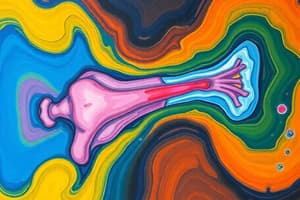Podcast
Questions and Answers
What are the two mechanisms by which bone forms?
What are the two mechanisms by which bone forms?
- Intramembranous ossification
- Both A and B (correct)
- Osteogenesis
- Endochondral ossification
What is intramembranous ossification?
What is intramembranous ossification?
A mechanism by which flat bones of the skull, face, mandible, and clavicle form directly within a membrane of vascular mesenchyme.
Intramembranous ossification is the primary mechanism for long bone formation.
Intramembranous ossification is the primary mechanism for long bone formation.
False (B)
What are osteoblasts?
What are osteoblasts?
What matrix do osteoblasts initially deposit during intramembranous ossification?
What matrix do osteoblasts initially deposit during intramembranous ossification?
What is endochondral ossification?
What is endochondral ossification?
Where does primary ossification begin in endochondral ossification?
Where does primary ossification begin in endochondral ossification?
The soft osteoid of primary bone undergoes __________.
The soft osteoid of primary bone undergoes __________.
What happens to chondrocytes during the process of endochondral ossification?
What happens to chondrocytes during the process of endochondral ossification?
Flashcards are hidden until you start studying
Study Notes
Histogenesis of Bone
- Bone formation occurs through two primary processes: intramembranous ossification and endochondral ossification.
Intramembranous Ossification
- Bone develops directly within a highly vascular mesenchymal membrane.
- This mechanism is responsible for forming flat bones of the skull, face, mandible, and clavicle.
- Mesenchymal cells differentiate into osteoprogenitor cells, which then become osteoblasts.
Osteoid Formation
- Basophilic osteoblasts produce osteoid, the organic bone matrix containing collagen, proteoglycans, glycoproteins, and GAGs.
- The initial bone formed is primary (immature, woven) bone, characterized by randomly oriented type I collagen fibers.
- Primary bone first appears as eosinophilic spicules and trabeculae, creating a three-dimensional network in the mesenchyma.
Osteoblastic Activity
- Osteoblasts secrete osteonectin (a connector for collagen and hydroxyapatite), sialoproteins (osteopontin aids in binding cells to bone), and osteocalcin (traps calcium for mineralization).
- The soft osteoid undergoes mineralization, leading to the formation of osteocytes trapped in lacunae, with cytoplasmic processes in canaliculi.
Bone Growth and Remodeling
- Ongoing mitosis of mesenchymal cells creates new osteoprogenitor cells that continue to differentiate into osteoblasts.
- Bone matrix is deposited via appositional growth on existing spicules and trabeculae.
- Primary bone is replaced by secondary (mature, lamellar) bone after resorption by osteoclasts, with spongy bone forming initially before potentially becoming compact bone.
- The surrounding highly vascular connective tissue develops into bone marrow, with mesenchymal tissue also contributing to periosteum and endosteum formation.
Endochondral Ossification
- Begins around the 12th week of gestation, involving the formation of a cartilage model that is later replaced by bone.
- This process is associated with the development of long bones in limbs and the vertebrae.
Primary Ossification Center
- Located in the diaphysis, it starts with creating a miniature hyaline cartilage model derived from mesenchyme.
- Cartilage undergoes interstitial and appositional growth while retaining the shape of a bone.
- Vascularization of the perichondrium prompts chondrogenic cells to differentiate into osteoprogenitor cells, leading to periosteum formation.
- New osteoblasts generate bone matrix for a subperiosteal bony collar using intramembranous ossification.
- As the collar develops, cartilage cells hypertrophy, the matrix calcifies, and the lack of nutrients leads to chondrocyte death through calcification, not mineralization.
Studying That Suits You
Use AI to generate personalized quizzes and flashcards to suit your learning preferences.




